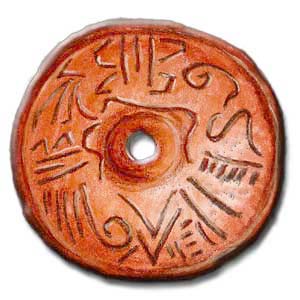


Formulas inscribed on a spindle whorl from Dikili Tash
This
inscribed spindle whorl is 6,000 years old and comes from Dikili Tash
(Greek Thrace).
This complex inscription on the spindle whorl has long, complex writings
that follow the circular movement of the tool and consists of glyphs with
a specific identity and recalling those of seals and tablets.
In Old Europe weaving is generally closely linked to myths and religious
rites and the act of spinning is full of allegorical and sacred force.
It is thus difficult to explain these inscriptions with their practical
use. Spindle whorls are among the most significant votive offerings found
in cult centres and burial grounds.
The whorls rotate when in use and it is thus possible that the geometric
motifs represent writing with cyclical, periodic features. Or are they
meant to be read by the faithful or the divinity as the whorl turns? Is
this a kind of prayer directed towards to the heavens like the Tibetan
prayer wheels?
The inscription from Dikili Tash could be a ritualistic formula for expressing
devotion, requests or gratitude or could describe a myth.
References:
Haarmann
H., Early Civilization and Literacy in Europe. An Inquiry Into Cultural
Continuity in the Mediterranean World, Berlino, New York, 1995.
Merlini
M., Was Writing Born in Europe? Searching for a Sacred Script, Rome (
in preparation )